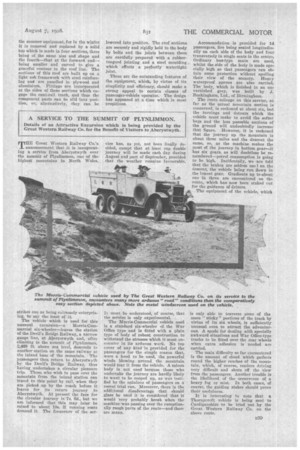A SERVICE TO THE SUMMIT OF PLYNLIMMON.
Page 57

If you've noticed an error in this article please click here to report it so we can fix it.
Details of an Attractive Excursion which is being provided by the Great Western Railway Co. for the Benefit of Visitors to Aberystwyth, THEGreat Western Railway Co.'s announcement that it is inaugurating a service from. Aberystwyth over the summit of Plyulimmon, one of the highest mountains in North Wales,
strikes one as being extremely enterprising, to say the least of it.
The vehicle which is used for this unusual excursion—a Morris-Coinniercial six-wheeler—leaves the station of the Devil's Bridge Railway, a narrow gauge line, at Aberystwyth and, after climbing to the summit of Plynlimmon, 2.469 ft above sea level, descends to another station on the same railway at the inland base of the mountain. The passengers then return to Aberystwyth by the Devil's Bridge Railway, thus having undertaken a circular pleasure trip. Those who wish to pass over the mountain from the inland station can travel to this point by rail, when they are picked up by the coach before it leaves for its return journey to Aberystwyth. At present the fare for the circular journey is 7s. 6d., but we are informed that this may later be raised to about 10s. if running costs demand it. The frequency of the ser
vice has, as yet, not been finally decided, except that at least one double journey will be made each day during August and part of September, provided that the weather remains favourable.
It must be understood, of course, that the service is only experimental.
The Morris-Commercial vehicle used is a standard six-wheeler of the War Office type and is fitted with a plain type of body of robust construction to withstand the stresses which it must encounter in its arduous work. No top cover of any kind is provided for the passengers for the simple reason that, were a hood to be used, the powerful winds blowing around the mountain would tear it from the vehicle. A saloon body is not used because those who undertake the journey are hardly likely to want to be cooped up, as was testified by the opinions of passengers on a recent trial run. Moreover, there is the additional disadvantage that should glass be used it is considered that it would very probably break when the machine was passing over the exceptionally rough parts of the route—and these Ore many. Accommodation is provided for 14 passengers, five being seated longitudinally on each side of the body and four transversely in single scats in the centre. Ordinary bus-type seats are used, whilst the side of the body is made specially high so that passengers can obtain some protection without spoiling their view of the scenery. Heavy waterproof aprons are also carried. The body, which is finished in an unvarnished grey, was built by 3. Buckingham, Ltd., of Birmingham.
The route mileage on this service, so far as the actual mountain section is concerned, is reckoned at about six, but the turnings and detours which the vehicle must make to avoid the softer bogs and the less passable sections of the ground will undoubtedly increase that figure. However, it is reckoned that the journey up the mountain is about three miles and the descent the same, so, as the machine makes the most of the journey in bottom gear—it has six gears, as will doubtless be remembered—petrol consumption is going to be high. Incidentally, we are told that the brakes are seldom use I on the descent, the vehicle being run down in the lowest gear. Gradients up to about one in three are encountered on the route, which has now been staked cut for the guidance of drivers.
The equipment of the vehicle, which is only able to traverse some of the more " sticky " portions of the track by virtue of its six wheels, is sufficiently unusual even to attract the adventurous. A spade for dealing with specially awkward situations and War Office-type tracks to be fitted over the rear wheels when extra adhesion is needed are carried.
The main difficulty so far cncouutered is the amount of cloud which gathers round the higher reaches of the mountain, which, of course, renders driving very difficult and shuts off the view from the passengers. Another trouble is the likelihood of the occurrence of a heavy fog or mist. In both cases, of course, the [priding stakes should prove their usefulness.
It is interesting to note that a Thornycroft vehicle is being sent to Cardiganshire to be tried out by the Great Western Railway Co. on the above route.




































































































